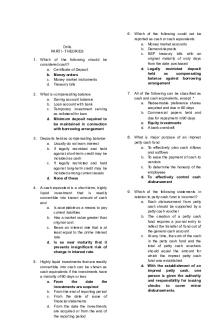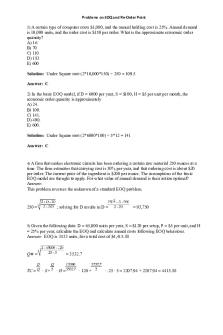Accounting for Materials - Problems with answers PDF

| Title | Accounting for Materials - Problems with answers |
|---|---|
| Author | val flores |
| Course | Accountancy |
| Institution | Tarlac State University |
| Pages | 13 |
| File Size | 659.2 KB |
| File Type | |
| Total Downloads | 785 |
| Total Views | 868 |
Summary
Problem 1An invoice for Part A, Part B, and Part C is received from Edison Company. Invoice totals are: Part A, $8,600; Part B, $5,060; and Part C, $3,840. The shipment weights 1,400 kilograms and freight charges are $280. Weights for the respective materials are 630, 440, and 330 kilograms.Required...
Description
Problem 1 An invoice for Part A, Part B, and Part C is received from Edison Company. Invoice totals are: Part A, $8,600; Part B, $5,060; and Part C, $3,840. The shipment weights 1,400 kilograms and freight charges are $280. Weights for the respective materials are 630, 440, and 330 kilograms. Required: 1. Allocate freight to materials based on cost. 2. Allocate freight to materials based on shipping weight.
Problem 2 Stevens Inc. has an annual usage of 100 units of Item M, having a purchase price of $55 per unit. The following data are applicable to Item M: Ordering Cost Carrying cost percentage
$5 per order 15%
Required: Compute the economic order quantity.
Problem 3 Lee Equipment Company estimates a need for 2,250 units of Material A next year at a cost of $3 per unit. The estimated carrying cost is 20% and the cost to place an order is $12. Required: Compute the economic order quantity.
Problem 4 Tunsel Corporation has been buying Product A in lots of 1,200 units, which represents a four-month supply. The cost per unit is $100; the order cost is $200 per order; and the annual inventory carrying cost for one unit is $25. Required: Compute the economic order quantity.
Problem 5 Mozart Company estimates that it will need 25,000 cartons next year at a cost of $8 per carton. The estimated carrying cost is 25% of average inventory investment, and the cost to place an order is $20. Required: Compute the following: 1. Economic Order Quantity 2. The frequency, in days, that orders should be placed, based on a 365-day year.
Problem 6 The Webb Company estimates that it will need 18,000 units of Material X next year, at a cost of $15 per unit. The estimated carrying cost is 20% of average inventory investment and the cost to place an order is calculated to be $15. Required: Compute the following: 1. Economic Order Quantity 2. The frequency, in days, that orders should be placed, based on a 365-day year. 3. The EOQ if Material X costs $6 per unit and other estimates remain unchanged.
Problem 7 A material is purchased for $3 per unit. Monthly usage is 1,500 units, the ordering cost is $50 per order, and the annual carrying cost is 40%. Required: 1. Compute the EOQ. 2. Determine the proper order size if the material can be purchased at a 5% discount in lots of 2,000 units.
Problem 8 Rediken Company buys 500 boxes of Item X-100 every two months. Order costs are $380 per order; carrying costs are $1 per unit and vary directly with inventory investment. Currently the company purchases the item for $5 each. Required: 1. Determine the total ordering cost and carrying cost under current policy.
2. Determine the EOQ and the related ordering and carrying costs. 3. What is the optimal order size if the supplier offers a 5% discount for orders of 3,000 units?
Problem 9 Starkville Company’s usage of Material A is 9,600 units during 240 working days per year. Lead time is 20 working days. Required: 1. Determine the Order Point. 2. Determine the safety stock and order point if the maximum lead time is 35 working days.
Problem 10 Pilot Company has obtained the following costs and other data pertaining to one of its materials: Order quantity 3,500 units Normal use per day 500 units Maximum use per day 600 units Minimum use per day 100 units Lead time 5 days Required: Compute the following: 1. Safety Stock (maximum) 2. Order point 3. Normal maximum inventory 4. Absolute maximum inventory
Problem 11 The Jansen Company is setting up an inventory control system. For one type of material, the following data have been assembled; Order quantity 3,000 units Normal use per day 120 units Maximum use per day 200 units Minimum use per day 80 units Lead time 5 days Required: Compute the following: 1. Safety Stock (maximum) 2. Order point 3. Normal maximum inventory 4. Absolute maximum inventory
Problem 12 Sunnyvale Inc. would like to determine the safety stock in needs to maintain for a product, to incur the lowest combination of stock-out cost and carrying cost. Each stock-out costs $75; the carrying cost for each safety stock unit is $1; the product is ordered five times a year. The following probabilities of running out of stock during an order period are associated with various safety stock levels. Safety Stock Level Probability of Stock-out 10 units 40% 20 20 40 8 80 4 Required: Determine the combined stock-out and safety stock carrying cost associated with each level and the recommended level of safety stock.
Problem 13 Meyer Company made the following materials purchases and issues during January.
Inventory: Receipts:
Jan. Jan.
Issues:
Jan.
1 6 10 25 15 27
Units 500 200 400 500 560 400
Price $1.20 1.25 1.30 1.40
Required: Compute the cost of materials consumed and the cost assigned to the inventory at the end of the month, using a perpetual inventory system combined with each of the following: 1. Average 2. FIFO 3. LIFO FIFO - 882 Average
LIFO
Problem 14 Assume that Absolute Company uses JIT costing for the production of goods during the month of January. All conversion costs are charged to the cost of goods sold account. At the end of each month, all inventory account balances are adjusted. Raw material cost is backflushed from RIP to Finished Goods and from Finished Goods to Cost of Goods Sold. The following transactions summarize the major steps in Absolute’s production during the month of January. 1. Raw materials received from suppliers amounted to $4,000....
Similar Free PDFs

Accounting For Materials Cost
- 26 Pages

Density Problems with Answers
- 2 Pages

Auditing Problems with Answers
- 12 Pages

Accounting Theories with Answers
- 3 Pages

Chapter 6 Accounting for Materials
- 14 Pages

Notes on Accounting for Materials
- 11 Pages

Problems on EOQ with answers
- 5 Pages
Popular Institutions
- Tinajero National High School - Annex
- Politeknik Caltex Riau
- Yokohama City University
- SGT University
- University of Al-Qadisiyah
- Divine Word College of Vigan
- Techniek College Rotterdam
- Universidade de Santiago
- Universiti Teknologi MARA Cawangan Johor Kampus Pasir Gudang
- Poltekkes Kemenkes Yogyakarta
- Baguio City National High School
- Colegio san marcos
- preparatoria uno
- Centro de Bachillerato Tecnológico Industrial y de Servicios No. 107
- Dalian Maritime University
- Quang Trung Secondary School
- Colegio Tecnológico en Informática
- Corporación Regional de Educación Superior
- Grupo CEDVA
- Dar Al Uloom University
- Centro de Estudios Preuniversitarios de la Universidad Nacional de Ingeniería
- 上智大学
- Aakash International School, Nuna Majara
- San Felipe Neri Catholic School
- Kang Chiao International School - New Taipei City
- Misamis Occidental National High School
- Institución Educativa Escuela Normal Juan Ladrilleros
- Kolehiyo ng Pantukan
- Batanes State College
- Instituto Continental
- Sekolah Menengah Kejuruan Kesehatan Kaltara (Tarakan)
- Colegio de La Inmaculada Concepcion - Cebu








